# Validator consolidation in EIP-7251
<img src=https://storage.googleapis.com/ethereum-hackmd/upload_aeef15040e04ae3c61d570e38be451e5.png width=89%>
$\cdot$
*by [francesco](https://twitter.com/fradamt), [mike](https://twitter.com/mikeneuder), & [mikhail](https://twitter.com/mkalinin2)*
-- *based on extensive discussions with [Lion](https://twitter.com/dapplion), [Roberto](https://twitter.com/robsaltini), [Sandra](https://twitter.com/sandJohnson), & [Barnabé](https://twitter.com/barnabemonnot)*
-- *tuesday, january 23, 2024*
$\cdot$
***tl;dr;*** *[EIP-7251](https://eips.ethereum.org/EIPS/eip-7251) increases the `MAX_EFFECTIVE_BALANCE` of Ethereum validators to 2048 `ETH` while preserving the 32 `ETH` minimum. "In-protocol consolidation", a key [feature](https://notes.ethereum.org/@mikeneuder/eip7251-features) in the EIP, allows validators to merge their effective balances (thus becoming a single validator with the combined stake) \~without\~ fully exiting and re-entering the protocol through the activation queue. This feature is critical to enable large staking pools that wish to merge validators because it allows them to do so without sacrificing significant rewards during the consolidation period. Due to the importance of this feature, we present an FAQ document that aims to answer the natural questions about the process and justify the design decisions.*
$\cdot$
[***EIP-7251: related work***](https://gist.github.com/michaelneuder/cafabcfcfcccc45e44ab9d6b1c7b4e1d)
$\cdot$
---
### What and why of in-protocol consolidation
***What is in-protocol consolidation?***
- [EIP-7251](https://eips.ethereum.org/EIPS/eip-7251) increases the `MAX_EFFECTIVE_BALANCE` for validators in the Ethereum consensus layer. This does not affect the 32 `ETH` minimum needed to join the validator set, but rather it raises the maximum balance validators can have to 2048 `ETH`. See the [related work](https://gist.github.com/michaelneuder/cafabcfcfcccc45e44ab9d6b1c7b4e1d) for more context. To facilitate the adoption of the EIP, we are proposing a mechanism by which validators can merge without fully exiting and re-entering the consensus layer. The consolidation process allows a `source` validator to designate a `target` validator as the recipient of its effective balance. The consolidation is authenticated through signatures from both the `source` and `target` validators and asserts that the merging is authorized by checking that both validators have the same withdrawal credential.
***Why do we need in-protocol consolidation?***
- EIP-7251 is most effective if the [large staking pools](https://www.rated.network/?network=mainnet&view=pool&timeWindow=1d&page=1&poolType=all) opt in to consolidating their stake onto fewer validators. Without an in-protocol consolidation mechanism, they would be required to fully exit their validators and redeploy the stake in a single larger validator (e.g., voluntarily exit 10 different 32 `ETH` validators to activate a single 320 `ETH` validator). This results in the 320 `ETH` sitting in the activation queue and not earning rewards for the pool, strongly disincentivizing consolidation – this is particularly painful if the activation queue becomes full again. If instead, they can signal their intent to merge validators through the protocol, that stake can skip the activation queue and continue earning rewards, despite being reallocated to a different validator.
***What is the endgame for in-protocol consolidation?***
- In-protocol consolidation is an interim solution to a problem (many redundant validator indices) that only exists because of the historical context of the original value of the `MAX_EFFECTIVE_BALANCE` being set at 32 `ETH`. Once node operators and stakers have the flexibility to deploy validators with variable sizes according to their infrastructure configurations and personal preferences, the consolidation function will likely no longer be critical. For example, instead of deploying two 32 `ETH` validators and consolidating them through the protocol, we would expect the staker to deploy a single 64 `ETH` validator (or start with a 32 `ETH` validator and add a deposit of another 32 `ETH` later). Despite this reality, in the short to medium term, this feature is by far the most important in terms of getting consolidation to take place.
***Why should we do EIP-7251 if we can't guarantee consolidation?***
- As mentioned above, consolidation will be opt-in. This begs the question of the benefits of EIP-7251, given the worst-case scenario is no consolidation takes place (rendering the EIP essentially a no-op). In our opinion, it is still worth doing EIP-7251 for three key reasons.
1. <u>Reason 1: we can expect some amount of initial consolidation.</u> First and foremost, node operators can benefit from consolidation because it reduces the number of validators that they need to manage. Coinbase, for example, runs at least [139,000](https://www.rated.network/o/Coinbase?network=mainnet&timeWindow=1d&idType=pool) validators. This is a lot of key management and reducing this complexity could reduce their OpEx significantly. There are currently [$\approx 900,000$ validators](https://www.validatorqueue.com/) in the set; in a fully-consolidated world, this would be reduced to $64x$ to $\approx 14,000$ validators. In reality, we expect a much more modest amount of consolidation, but even $900,000 \rightarrow 600,000$ would be a huge accomplishment and would set us up well to handle a large influx of new capital in the case that staking demand increases significantly during the next market cycle.
2. <u>Reason 2: Solo staking is significantly improved.</u> Reducing the overall validator set size through large validator consolidation is the big ticket item for EIP-7251, but the solo staker UX improvements should not be overlooked. First, solo stakers immediately can start to benefit from auto-compounding of their staking rewards. Rather than needing to deploy another 32 `ETH` validator, the solo stakers may immediately begin earning rewards on any balance they accumulate above the 32 `ETH` principal (this is accomplished by the solo staker updating their withdrawal credential to indicate that they would like to avoid their excess balance being swept off, thus opting into compounding rewards). Historically, auto-compounding has only been accessible through joining a staking pool. Additionally, flexible balances allow solo stakers who have some amount of capital beyond the 32 `ETH` that they would like to stake (e.g., someone with 40 `ETH` can solo stake it all rather than needing solo staking 32 `ETH` and delegating 8 `ETH` to a staking pool).
3. <u>Reason 3: Variable balances are always going to be part of the Ethereum endgame.</u> The endgame of Ethereum depends on single-slot finality. As Vitalik [recently wrote](https://ethresear.ch/t/sticking-to-8192-signatures-per-slot-post-ssf-how-and-why/17989), depending on continued optimization of BLS signature aggregation doesn't seem like a viable path forward. Variable validator balances are a core piece of a Proof-of-Stake protocol, so enshrining it now is future-compatible and forward-looking. If we later choose to incentivize further consolidation (either through a carrot or a stick), that discussion can be detangled from the exact mechanics of increasing the `MAX_EFFECTIVE_BALANCE` and stand alone as a much simpler EIP.
---
### How in-protocol consolidation works
***How does a voluntary exit work again? (refresher)***
- Voluntary exits are not changed with EIP-7251, but it is helpful to have the process in mind when explaining the consolidation details. The figure below demonstrates the flow of a voluntary exit.

- Once the `VoluntaryExit` is included in the `BeaconBlock`, the `initiate_validator_exit` function is called, which sets the `exit_epoch` and `withdrawable_epoch` for the validator in the `BeaconState`. The `exit_epoch` depends on the churn limit, and the validator must continue performing their consensus duties until this epoch. The `withdrawable_epoch` is just the `exit_epoch + MIN_VALIDATOR_WITHDRAWABILITY_DELAY`, where `MIN_VALIDATOR_WITHDRAWABILITY_DELAY=256` is a spec-defined [constant](https://github.com/ethereum/consensus-specs/blob/dev/specs/phase0/beacon-chain.md#time-parameters-1). The validator is slashable until the `withdrawable_epoch` is reached, at which point their withdrawal is processed and their `ETH` is sent to the address specified in their withdrawal credential. The figure below shows the timeline of events for a voluntary exit. 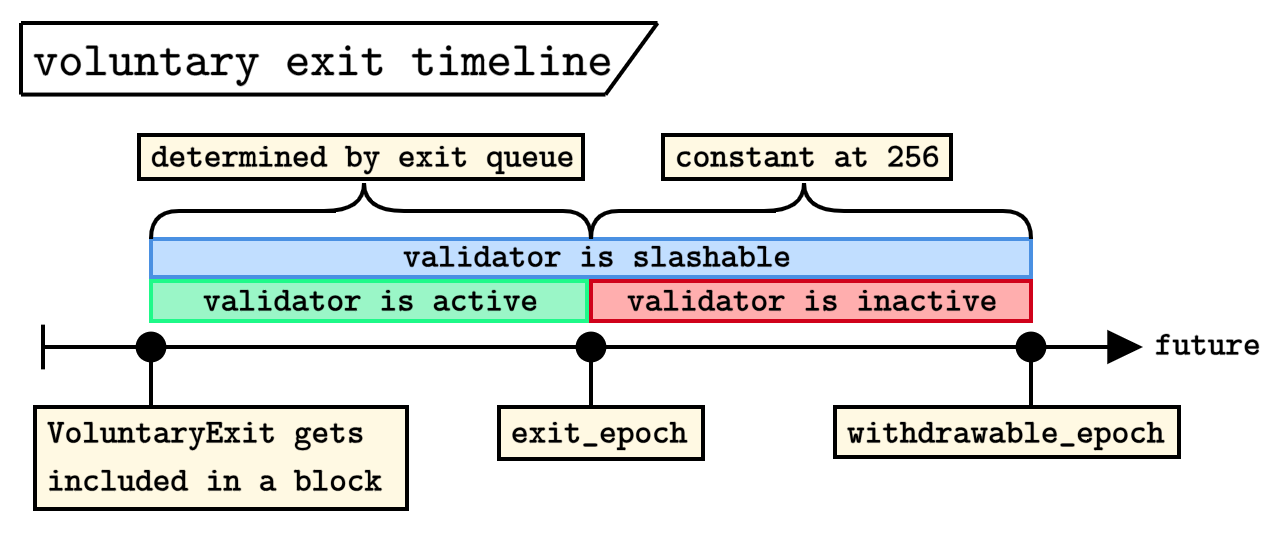
***What is the in-protocol consolidation process?***
- In the same way that a validator broadcasts their `VoluntaryExit` message and it gets included in a block, both validators that would like to consolidate sign a `Consolidation` object and gossip it over the p2p layer. Once this consolidation is included in a block, it is processed and the merging of the two validators begins. An exit for the `source` validator is triggered and once the exit is complete, their balance is fully allocated to the `target` validator, bypassing the activation queue. *Crucially, as with normal exits, the `source` validator is active and keeps earning rewards while in the exit queue*. The figure below demonstrates this flow. 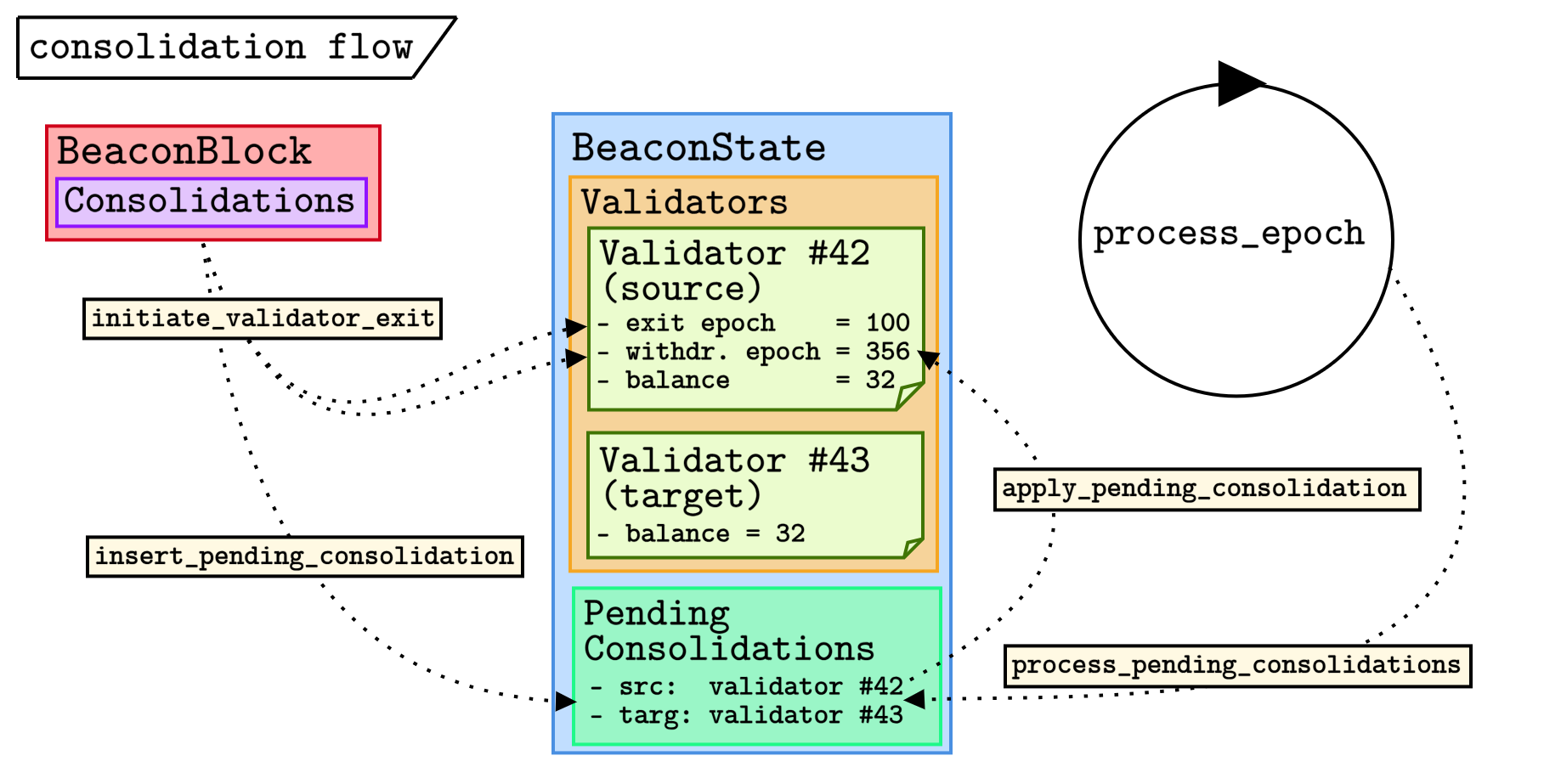
- When the consolidation in the block is processed, the source validator's voluntary exit is triggered. Additionally, a pending consolidation is inserted into the `BeaconState`. When the epoch processing takes place, any pending consolidation where the `withdrawable_epoch` has been reached transfers the balance to the `target` validator. If by the time `process_pending_consolidation` is called in the `withdrawable_epoch`, the `source` validator has been slashed, then the consolidation operation is canceled.
***What are the implications for the `source` and `target` validator rewards during a consolidation period?***
- Let's define two phases of the consolidation process.
1. *`source` exit phase*. The epochs between the `Consolidation` object being included onchain and the assigned `exit_epoch` for the `source` validator. The length of this phase depends on the exit queue.
2. *`source` withdrawal phase*. The 256 epochs (as defined by [`MIN_VALIDATOR_WITHDRAWABILITY_DELAY`](https://github.com/ethereum/consensus-specs/blob/dev/specs/phase0/beacon-chain.md#time-parameters-1)) between the `exit_epoch` and `withdrawable_epoch` of the `source` validator.
- During (1), the `source` validator is earning rewards and participating in consensus. During (2) the `source` validator is not earning rewards nor participating in consensus. The `target` validator is earning rewards during both (1) and (2). *Note that this implies the consolidating validator is not earning rewards during the 256-epoch period between the exit and the withdrawal. This is a fixed amount of time, about 27 hours, independent of the size of the exit queue.* The figure below shows the slashability and stake of two consolidating validators. 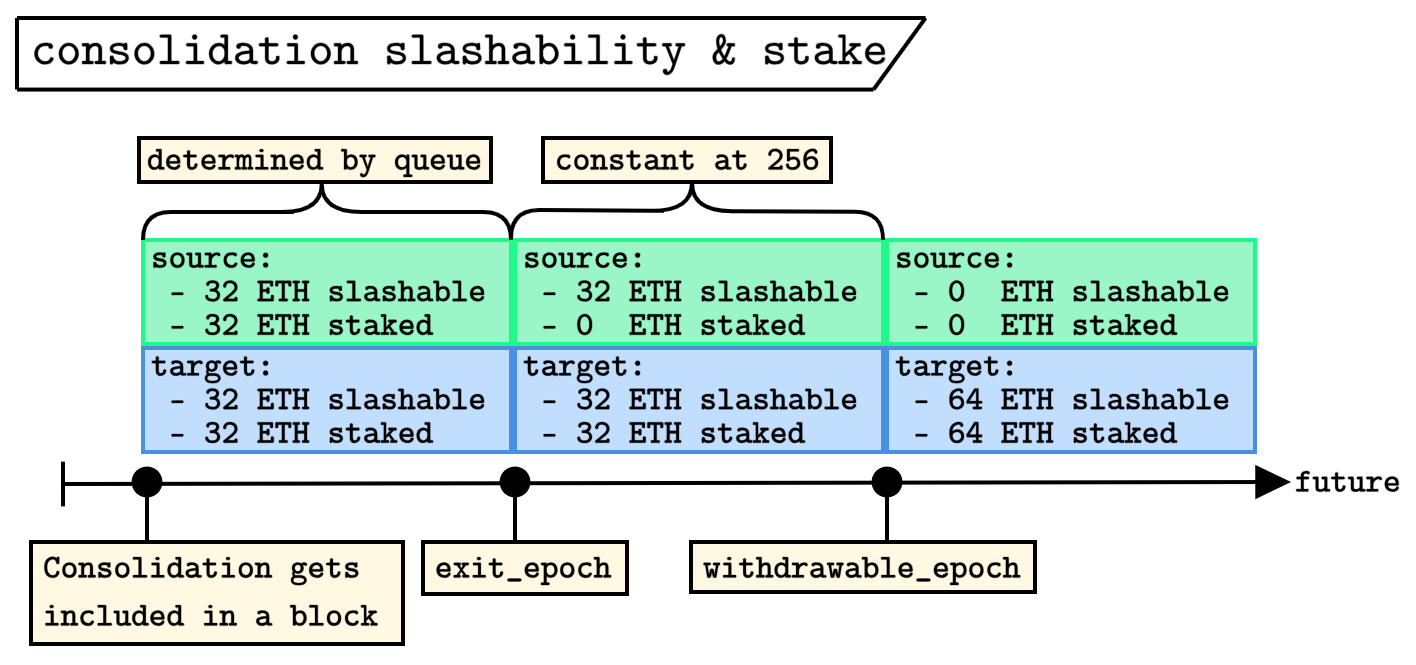
***How is slashing attributed during a consolidation?***
- During the consolidation period, each validator is slashable for the stake that they each had initially (32 `ETH` in the base case). Once the exit period has ended, the `source` validator can safely stop participating in consensus (they are no longer active validators), but they are still slashable until the `withdrawable_epoch` (as with a normal voluntary exit). Once the `withdrawable_epoch` is reached, their balance is instantaneously transferred to the `target` validator, who is now accountable for the full combined balance. In short, when the `source` validator `withdrawable_epoch` is reached, the slashability of the `source` stake is instantly transferred to the `target` validator (see figure above).
***Why do consolidating validators need to have the same withdrawal credential?***
Exactly as in the case of a withdrawal, it is not safe to authenticate a `Consolidation` through the BLS staking key, because it is only the withdrawal credential that should have ownership of the funds. Unfortunately, the CL is not currently able to check EL signatures, so being able to process `Consolidation` operations with arbitrary `source` and `target` would require either:
- Introducing the secp256k1 curve in the Consensus Layer
- Having `Consolidation` operations be processed by the Execution Layer, similarly to EL-triggered withdrawals.
Either option widens the scope of this feature significantly, bringing extra complexity to an EIP that already has a lot of moving parts and some cross-layer interactions.
Therefore, we think it is best to make the consolidation feature more limited, by restricting it to `source` and `target` validators which have the same withdrawal credential. No signature from the withdrawal credentials is needed in this case, because the `Consolidation` does not change the ultimate owner of the funds. We can then just authenticate the operation by checking a signature by the staking key of the `source` validator, as we would for an exit. From discussions with large node operators, this doesn't seem to be a severe limitation. Lido for example, only has a single withdrawal credential for all of their validators across different node operators. Many other staking operations reuse withdrawal credentials, making the consolidation feasible for them as well.
***Why can we only consolidate two validators at a time?***
- To simplify the design, the consolidation operation itself only contains two validators. However, many `source` validators can be concurrently merged into the same `target` (e.g., concurrent pairwise merging). For example, a node operator with a single `target` and can have two source validators `sourceA` & `sourceB` consolidating into it at the same time. The only constraint on this rate is due to the churn limit, there to preserves a sufficiently long weak subjectivity period, as we discuss later.
***How long does a single pairwise consolidation take?***
- The minimum consolidation time is the ~27 hours of the `MIN_WITH_VALIDATOR_WITHDRAWABILITY_DELAY`, and on top of that a `Consolidation` takes as long as the exit of the `source` validator. Like all the rate-limited queues in the consensus layer, this depends on the amount of usage in the queue at a given time. The churn limit for `Consolidation` operations is set to 256 `ETH` per epoch, equivalent to 8 validators of today. See the following set of questions for more details on the churn limit, weak subjectivity, and rate at which consolidation can occur.
---
### Consolidations and churn limit
**Define accountable safety and the weak subjectivity period.**
Accountable safety is the guarantee that two conflicting finalized checkpoints lead to the identification and slashing of at least $\frac{1}{3}$ of the stake. We get this from a simple quorum intersection argument: since we require a $\frac{2}{3}$ quorum to finalize, any two quorums must intersect in at least $\frac{1}{3}$ of the stake. In the context of a dynamic validator set, however, the quorum intersection property, and thus accountable safety, deteriorate over time, as more and more of the validator set is allowed to change. The guarantee that we have is instead of the following form: if two conflicting checkpoints are finalized within $n$ epochs of their highest common ancestor $\mathcal{C}$, then we can identify and slash $\frac{1}{3} - D(n)$ of the stake in $\mathcal{C}$, for an increasing function $D(n) \in [0,1]$ depending on the churn limits we set on activations and exits per epoch. For a desired maximum tolerable safety deterioration $D_0 \in [0, \frac{1}{3})$, the [weak subjectivity period](https://notes.ethereum.org/@adiasg/weak-subjectvity-eth2) is the minimum $n$ such that $D(n) \ge D_0$, i.e., the minimum number of epochs such that a conflicting finalization can happen without at least a $\frac{1}{3} - D_0$ of the stake being slashable.
**How do exits and activations affect the weak subjectivity period?**
Say we have two branches with diverging validator sets of total stake $S_1$ and $S_2$, and total stake $S$ *across the two branches*. Here, $S$ can be less than $S_1 + S_2$, if there still is overlap between the validator sets. Then, the minimum intersection of quora for the two branches (i.e. the minimum slashable stake in case of conflicting finalizations produced by these validator sets) is $\frac{2}{3}S_1 + \frac{2}{3}S_2 - S$, i.e., the sum of the quorum sizes minus the total stake.
Let's now use this to understand the effect of exits. In the figure, we start with a checkpoint $\mathcal{C}_0$ where the total stake is $S$, and throughout $n$ epochs the exit of $E$ stake is allowed. In two chains branching from $\mathcal{C}_0$, *different* sets of validators with cumulative stake $E$ are exited, and eventually conflicting checkpoints $\mathcal{C}_1$ and $\mathcal{C}_2$ are finalized. Due to the exits, the required quorum on either branch is now only $\frac{2}{3}(S - E)$, while the total stake across the two branches is still $S$, because all validators are still active on at least one of the two branches. Therefore, the minimum intersection between the quorum for $\mathcal{C}_1$ and the one for $\mathcal{C}_2$ is $2*\frac{2}{3}(S-E) - S = \frac{1}{3}S - \frac{4}{3}E$, corresponding to a safety loss of $\frac{4}{3}E$. Another way to think about this is that an exit of $E$ stake reduces the safety by $\frac{2}{3}E$ because it reduces the required quorum by that amount, and enacting different exits on two branches doubles the safety loss.
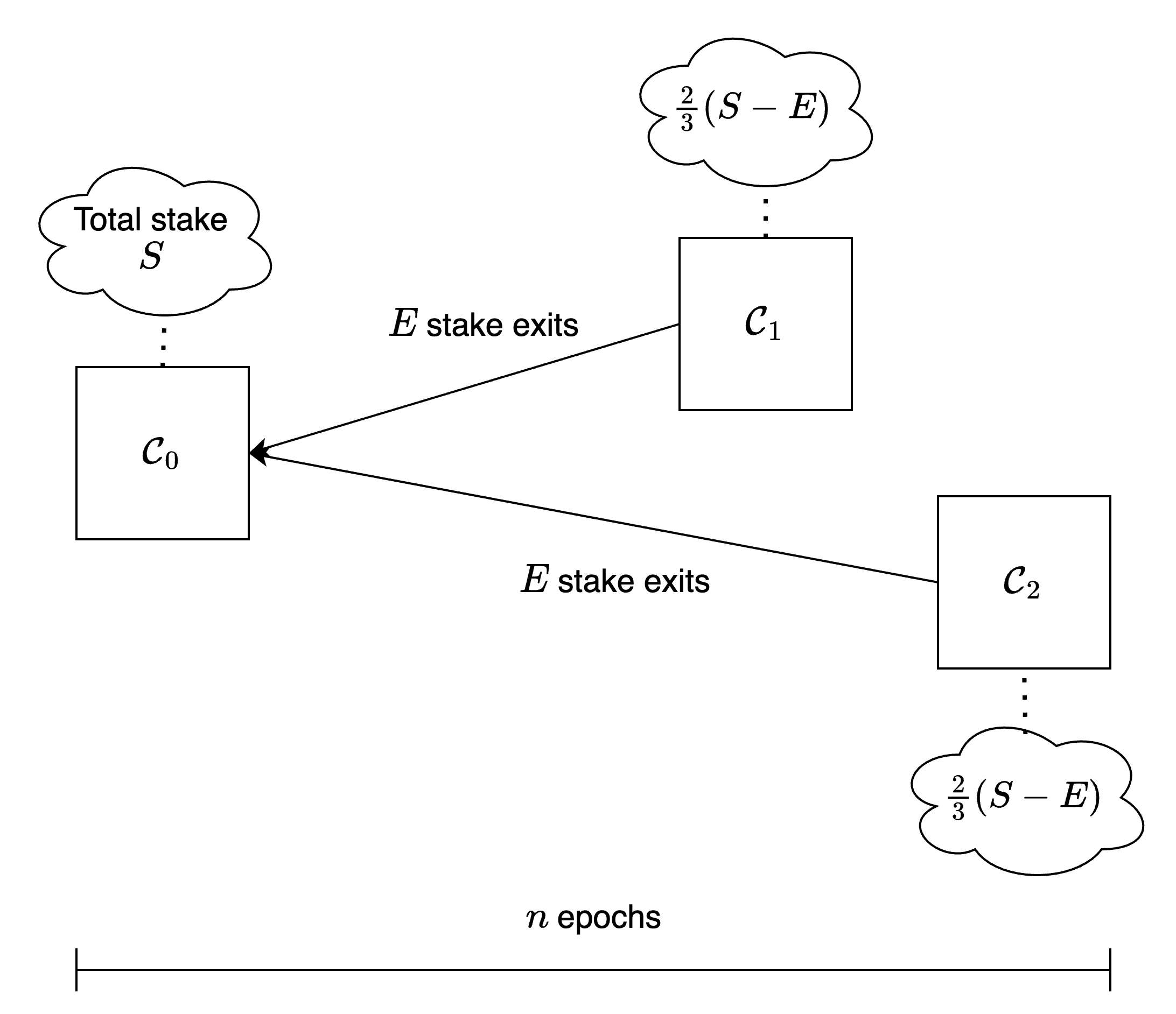
Let's do the same analysis for activations. Everything is as before, except instead of exits we have the activation of $A$ stake on either branch. Intuitively, the activation of $A$ stake should reduce safety by $A - \frac{2}{3}A = \frac{1}{3}A$. This is because the activating stake is free to vote for whatever it wants without being slashed, but it increases the required quorum by $\frac{2}{3}A$. Enacting different activations on two branches should again double the safety loss, for a total of $\frac{2}{3}A$. In fact, either branch now has a quorum of $\frac{2}{3}(S+A)$ and the total stake across the branches is $S + 2A$, so the minimum quorum intersection between the two is $2*\frac{2}{3}(S + A) - (S + 2A) = \frac{1}{3}S - \frac{2}{3}A$.
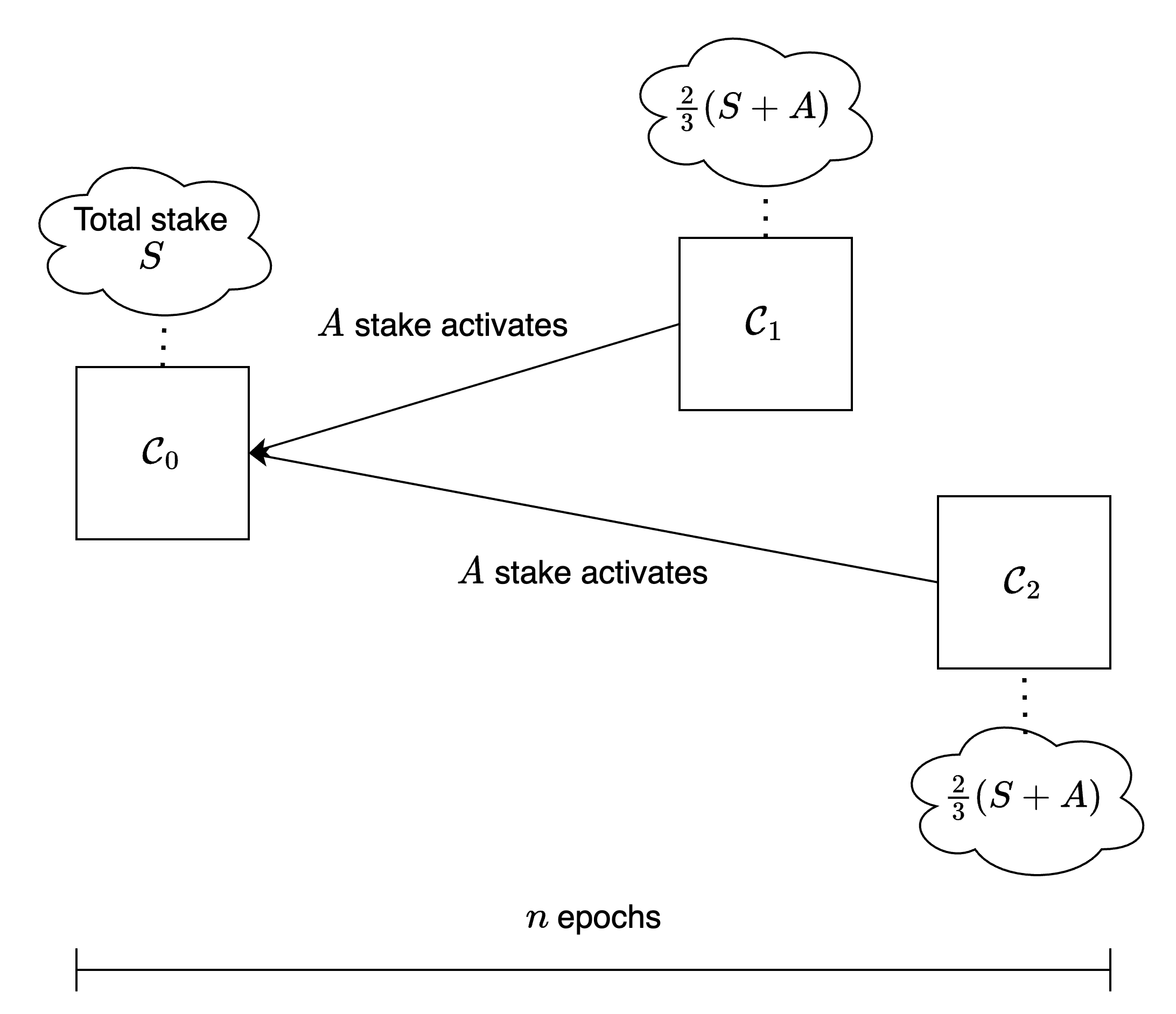
The effect of activations and exits (involving different validators) simply adds up: allowing activation of $A$ stake and exit of $E$ stake makes the quorum $\frac{2}{3}(S + A - E)$ and the total stake across both branches $S + 2A$, so the minimum quorum intersection is $\frac{4}{3}(S + A - E) - (S + 2A) = \frac{1}{3}S - \frac{2}{3}A - \frac{4}{3}E$.
With this, we can now compute the weak subjectivity period with a symmetric churn limit of $d$ stake per epoch both for activations and exits, and an initial total stake of $S$. After $n$ epochs, the minimum quorum intersection reduces to $\frac{S}{3} - \frac{2}{3}(n*d) + \frac{4}{3}(n*d) = \frac{S}{3} - 2n*d$, so the safety degradation is $D(n) = \frac{2n*d}{S}$. The weak subjectivity period for maximum tolerable safety loss $D_0$ is then $n = \frac{D_0S}{2d}$. You find this same expression [in this document](https://github.com/runtimeverification/beacon-chain-verification/blob/master/weak-subjectivity/weak-subjectivity-analysis.pdf), modulo the churn being expressed in validators per epoch rather than stake per epoch.
**How do consolidations affect the weak subjectivity period?**
A consolidation is equivalent to an exit followed by activation, so we would expect allowing consolidation of $C$ stake to cause a safety reduction of $\frac{2}{3}C + \frac{4}{3}C = 2C$, i.e., the effect of allowing exits and activations of $C$ stake. A single consolidation of $C$ stake causes a safety loss of exactly $C$ because the quorum is unchanged (we are only moving stake around, not changing the total amount), but the consolidated stake can now vote for whatever it wants, as with an activation. With consolidations in two different branches, we then get precisely to the expected safety reduction of $2C$. The consolidating stake is essentially free to jump from one quorum to a conflicting one without counting in the intersection: the consolidation frees it from any previous voting commitments made by the `source` validator, protecting it from slashing. To see this more concretely, just evenly divide the initial stake $S$ between two sets of validators $V_1$ and $V_2$. In one branch, the $C$ stake consolidates from $V_1$ to $V_2$, and in another chain, the opposite happens. In the first branch, $V_2$ has $\frac{S}{2} + C$ stake, so it only needs $\frac{2}{3}S - (\frac{S}{2} + C)$ stake from $V_1$ to reach a quorum and finalize, and the analog holds for $V_1$ in the second branch. Therefore, a double finalization only requires $\frac{4}{3}S - (S + 2C) = \frac{1}{3}S - 2C$ stake to be slashable. Were we to set the churn limit *for consolidations* at $d_C$ stake, the weak subjectivity period would then be $\frac{D_0S}{2(d + d_C)}$, equivalent to the effect of increasing the churn limit for both activations and exits by $d_C$.
**How do we avoid a reduction in the weak subjectivity period?**
In the Beacon Chain the [churn limit](https://github.com/ethereum/consensus-specs/blob/dev/specs/phase0/beacon-chain.md#get_validator_churn_limit) is not a fixed amount of stake, and instead depends on the total stake $S$. Up to the Deneb hard fork, it has been set to $\max(4, \frac{N}{2^{16}})$ *validators*, corresponding to $d(S) = \max(128, \frac{S}{2^{16}})$ stake in a post-MaxEB spec, where validators can have variable balance and the churn is measured in stake rather than validators. In Deneb, [EIP-7514](https://eips.ethereum.org/EIPS/eip-7514) introduces the `MAX_PER_EPOCH_CHURN_LIMIT` parameter, which bounds the *activation* churn to 8 validators. Incidentally, this has the effect of increasing the weak subjectivity period whenever the bound is active, i.e. whenever the number of validators is $> 2^{19}$, or in a post-MaxEB spec whenever the total stake is $> 2^{24}$. We propose to restore the symmetry of exits and activations by applying the same bound to the exit churn, and, whenever the total stake is $> 2^{24}$ and there is a "leftover" churn, to use that for consolidations. For example, if the total stake is $2^{25}$, the exit and activation churn would originally each have been set to 16 validators, equivalent to 512 ETH. The bound leaves a "weak subjectivity budget" of 256 ETH worth of exits and 256 ETH worth of activations, which correspond to 256 ETH worth of consolidations, and we set the consolidation churn limit precisely to this. In other words, we set the churn limit for activations and exits to $d_{AE}(S) = \min(256, d(S))$, and the churn limit for consolidations to $d_C(S) = d(S) - d_{AE}(S)$, so that the weak subjectivity period remains $\frac{D_0S}{2(d_{AE}(S) + d_C(S))} = \frac{D_0S}{2d(S)}$. Bounding the activation and exit churn can be just a temporary measure to allow for consolidations to happen, and we can eventually revert to the original churn limit and deprecate consolidations.
**How long would it take for the validator set to consolidate?**
This depends on the total stake $S$. If $S \le 2^{24}$, $d_C(S) = 0$ in our current proposal, so there cannot be any consolidation *through this feature*, though it is in principle still possible for consolidation to happen just through exits and activations. On the other hand, such a dramatic decrease in the amount staked is unforeseeable in the short term. With the current total stake of ~29M ETH, the consolidation churn would be $29\frac{2^{20}}{2^{16}} -256 = 208$ ETH per epoch. Consolidations do not affect the total amount of stake and therefore do not affect the churn limit, so consolidation of *all* validators would require at least $29M/208$ epochs, about ~21 months, assuming no significant net inflow from exit and activations affects the churn limit during the process either. At 32M staked, the consolidation churn would be 256 ETH per epoch and full consolidation would require at least ~19 months.
<iframe src="https://www.desmos.com/calculator/o9uegz2aqr?embed" width="500" height="500" style="border: 1px solid #ccc" frameborder=0></iframe>
-----
-----
-----
<!-- supporting in-protocol validator consolidation is a must-have feature in EIP-7251 (increasing the MAX_EFFECTIVE_BALANCE). @fradamt, @mkalinin2, and i wrote up a doc to answer some common questions and explain how it all fits together!
👤+👤 = 👥
↯↯↯
https://notes.ethereum.org/@fradamt/maxeb-consolidation
many thanks to @dapplion, @robsaltini, @sandJohnson, and @barnabemonnot for discussions on this intricate topic. for more details on EIP-7251, see this gist for the related work:
-->
<!--
**Is there some faster alternative?**
We have investigated alternative designs where consolidations do not need to be rate limited, which is in principle possible since the consolidating stake never leaves the system. Preventing the safety degradation that we have discussed above would require tracking a) ensuring that consolidations happen in the same way on every chain, i.e., only finalizing the order of consolidations before applying them, and b) tracking the `source` and `target` of a consolidation. In practice, there are serious fundamental and practical issues in such designs in the Ethereum context,
## Churn balance without losing rewards
### Summary of the flow
- block processing
+ each block can contain 4 `SignedConsolidation` objects
+ in `for_ops` for the block processing `process_consolidation` is called
+ asserts are made and the exit of the source is initiated. this is a normal exit
+ the consolidation is added to the `BeaconState` as a `PendingConsolidation`
- epoch processing
+ in `process_epoch` the function `process_pending_consolidations` is called
+ this loops through the pending consolidations and checks if it is the source exit epoch
+ if it is `apply_pending_consolidation` is called
+ this function puts all the balance from the source into the target
pros:
- simplicity
- get to use churn for guarantees around 1/3-slashable finality reversions
- separation of concerns between the two validator indeces (no cross-validator slashing accounting needed).
cons:
- requires same withdrawal credential to avoid EL interaction
qs:
- multiple or pairwise consolidation
- why 4 per-block?
- is it ok to have WC matching requirement?
+ could be alleviated by the fact that WC can be updated in the future
- no direct incentive to consolidate
+ can be remidied in the future (e.g., rewards scale with number of validators to incentivize big validators to consolidate).
.
- figures
- normal voluntary exit flow for a single validator for reference
- consolidation flow

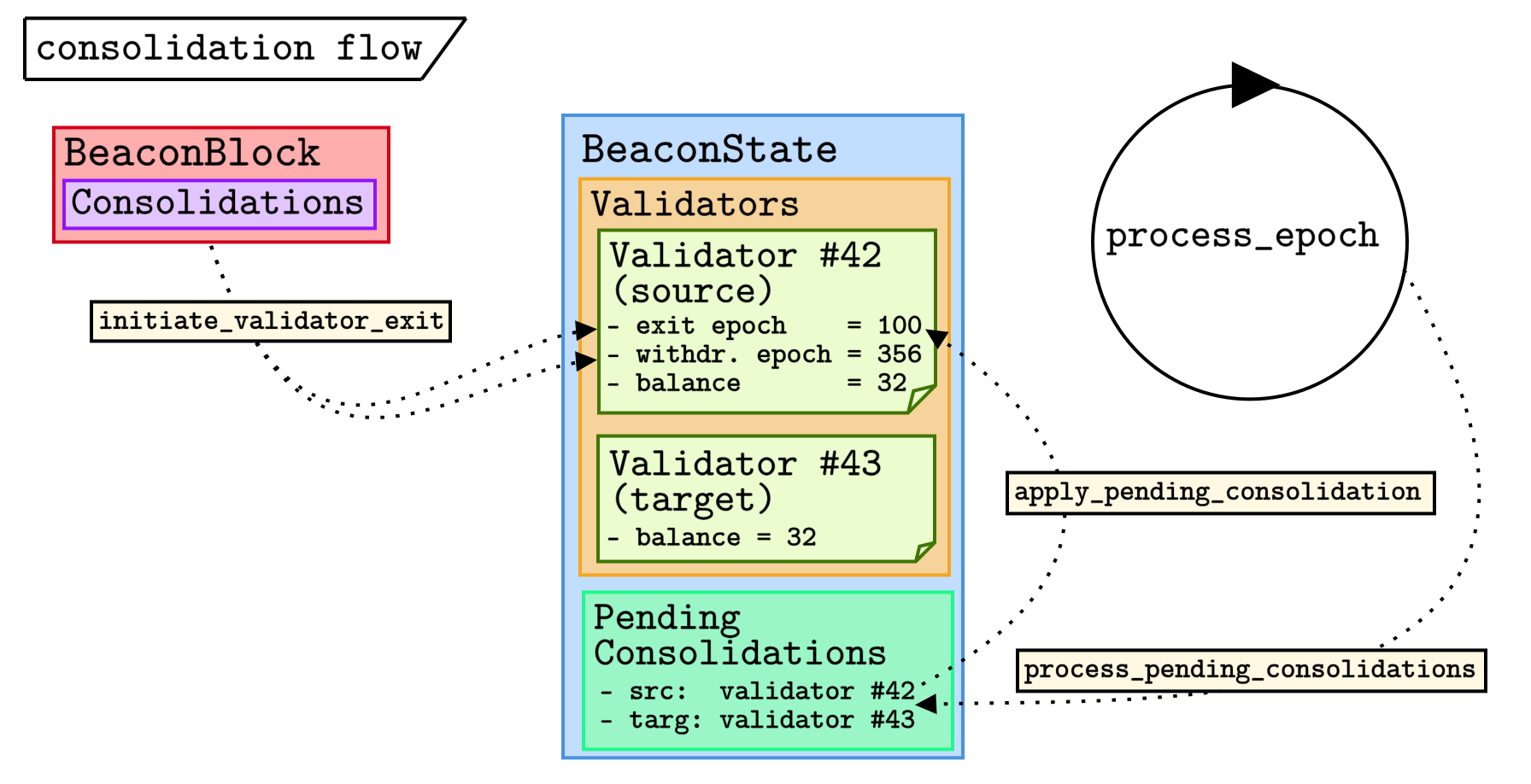
### High level ideas
- From the perspective of the source validator, a `Consolidation` is essentially the same as a `VoluntaryExit`. It does all the checks that a `VoluntaryExit` does, i.e., `epoch` has to be at least the specified one, the source validator has to be active and without an already assigned exit epoch, and the signature verifies. If so, it calls `initiate_validator_exit`.
- `process_consolidation` also sets the source validator's `consolidated_to` to `target_index`. At the epoch transition to `exit_epoch`, `process_consolidations` then recognizes that it's time for the consolidation from `source` to `target`, and it moves the active balance of `source` to `target`.
- Until the `exit_epoch`, `source` continues attesting and receiving rewards normally. After `exit_epoch`, its active balance is now with the target, and it contributes to its rewards. Any leftover balance will eventually be withdrawable by `source`.
### Main spec additions
```python
class Consolidation(Container):
source_index: ValidatorIndex
target_index: ValidatorIndex
epoch: Epoch
class SignedConsolidation(Container):
message: Consolidation
signature: BLSSignature
def process_consolidation(state: BeaconState, signed_consolidation: SignedConsolidation) -> None:
consolidation = signed_consolidation.message
target_validator = state.validators[consolidation.target_index]
source_validator = state.validators[consolidation.source_index]
# Verify the source and the target are active and not yet exited
assert is_active_validator(source_validator)
assert is_active_validator(target_validator)
assert source_validator.exit_epoch == FAR_FUTURE_EPOCH
assert target_validator.exit_epoch == FAR_FUTURE_EPOCH
# Verify the minimum epoch for processing the Consolidation
assert get_current_epoch(state) >= consolidation.epoch
# Verify the source and the target have Execution layer withdrawal credentials
assert source_validator.withdrawal_credentials[:1] in (ETH1_ADDRESS_WITHDRAWAL_PREFIX, COMPOUNDING_WITHDRAWAL_PREFIX)
assert target_validator.withdrawal_credentials[:1] in (ETH1_ADDRESS_WITHDRAWAL_PREFIX, COMPOUNDING_WITHDRAWAL_PREFIX)
# Verify the same withdrawal address
assert source_validator.withdrawal_credentials[1:] == target_validator.withdrawal_credentials[1:]
# Verify consolidation is signed by the source and the target
domain = compute_domain(DOMAIN_CONSOLIDATION, genesis_validators_root=state.genesis_validators_root)
signing_root = compute_signing_root(consolidation, domain)
pubkeys = [source_validator.pubkey, target_validator.pubkey]
assert bls.FastAggregateVerify(pubkeys, signing_root, signed_consolidation.signature)
# Exit source validator and set its consolidated_to to target index
initiate_validator_exit(state, source_index)
source_validator.consolidated_to = target_index
def process_consolidations(state: BeaconState) -> None:
current_epoch = get_current_epoch(state)
validators_to_consolidate = [v for v in state.validators
if v.consolidated_to != UNSET_CONSOLIDATED_TO
and v.exit_epoch == current_epoch]
for source_validator in validators_to_consolidate:
target_validator = state.validators[source_validator.consolidated_to]
apply_consolidation(state, source_validator, target_validator)
def apply_consolidation(state: BeaconState, source: Validator, target: Validator) -> None:
# Move active balance
active_balance_ceil = MIN_ACTIVATION_BALANCE if has_eth1_withdrawal_credential(source) else MAX_EFFECTIVE_BALANCE
active_balance = min(state.balances[source.index], active_balance_ceil)
state.balances[target.index] += active_balance
# Excess balance above current active balance ceil will be withdrawn
state.balances[source.index] = state.balances[target.index] - active_balance
# Update target exit and withdrawable epochs if the target exited
if target.exit_epoch != FAR_FUTURE_EPOCH:
target.exit_epoch = compute_exit_epoch_and_update_churn(state, active_balance)
target.withdrawable_epoch = Epoch(target.exit_epoch + config.MIN_VALIDATOR_WITHDRAWABILITY_DELAY)
```
## OLD
### Tracking slashing
```python
def is_consolidated(validator: Validator) -> bool:
validator.consolidated_to != UNSET_CONSOLIDATED_TO
def resolve_slashed_index(state: BeaconState, index: ValidatorIndex) -> ValidatorIndex:
if is_consolidated(state.validators[index]):
# Recursively resolve consolidated index
return resolve_slashed_index(state, state.validators[index].consolidated_to)
else:
return index
def process_attester_slashing(state: BeaconState, attester_slashing: AttesterSlashing) -> None:
attestation_1 = attester_slashing.attestation_1
attestation_2 = attester_slashing.attestation_2
assert is_slashable_attestation_data(attestation_1.data, attestation_2.data)
assert is_valid_indexed_attestation(state, attestation_1)
assert is_valid_indexed_attestation(state, attestation_2)
slashed_any = False
attesting_indices_1 = [resolve_slashed_index(state, index)
for index in attestation1.attesting_indices]
attesting_indices_2 = [resolve_slashed_index(state, index)
for index in attestation2.attesting_indices]
indices = set(attesting_indices_1).intersection(attesting_indices_2)
for index in sorted(indices):
if is_attester_slashable_validator(state.validators[index], get_current_epoch(state)):
slash_validator(state, index)
slashed_any = True
assert slashed_any
```
Problem: what happens on a chain where consolidation hasn't happened, or where it has happened to a different validator? E.g. on chain A validator n signs (B,N) but on chain B validator n consolidated to validator m and the latter signs (B',N). On chain B, the two messages resolve in a slashing of m, because index n resolves index m. On chain A however, this is not the case: n resolves just to n, and m just to m. It could even be the case that validator n is consolidated to some validator m' on chain B, so that n resolves to m', and we couldn't even hope to just wait for the consolidation of n -> m to first be processed, to then process the slashing. Two ways around it:
- Make equivocating consolidation slashable: if I sign multiple consolidation messages for the same validator, I get slashed. This way, it is always either possible to process the (unique) consolidation and then the attester slashing or to process the slashing for consolidation equivocation instead. Weird because it involves messing with slashing db. Also, would probably be best if the source verification was just a BLS signature, which would make sense only if source and target withdrawal credentials were the same. We'd probably want to also separately add a way to rotate withdrawal credentials for this to make sense.
- we could include consolidation evidence in the slashing itself. Problem with this is mostly the extra data involved. Not a huge deal though. Per validator to slash you might need to add a source and target index and two signatures, overall around 200 bytes. Not a huge deal given it's 200 bytes per at least 1 eth of slashing? Even with a different consolidation per validator, it would still be "only" 100 KBs to slash 500 validators... And there's only at most 2 attester slashings per slot? Maybe can even make the limit one for those of this kind...
Waiting for finalization of the consolidation, like with activation_eligibility_epoch? Basically the consolidation operation is processed on chain, when a validator is already active. We can potentially recycle activation_eligibility_epoch, or have a new `consolidation_eligiblity_epoch`. Since this is not something we need for every validator, we could even just have a list `consolidations_to_finalize`, which contains `VerifiedConsolidation` objects:
```python
class VerifiedConsolidation:
source: ValidatorIndex
target: ValidatorIndex
consolidation_eligibility_epoch: Epoch
```
At this point, we have already verified that the consolidation is authorized, and do not need to keep the signatures. This also means that it is ok for the source withdrawal credentials to change in the meantime (if an operation to do this were to exist). Even if that's the case, at this point we just go on with the consolidation anyway.
During epoch processing, we go through the list and finish processing consolidations where `consolidation_eligibility_epoch` is already finalized. Is this enough? Say there is a fork (in the finalized chain), but the last common checkpoint is at epoch N. We want to be able to slash any validators which have helped to caused the fork with votes "across consolidations". For example, it could be that in chain A epoch N was finalized, then epoch N+2, while in chain B epoch N was not finalized directly, and only epoch N+2 is finalized (with something different than in chain A). On chain A, consolidation happens already in the epoch processing from N+1 to N+2, when N is finalized. At this point, stake which has consolidated can vote for something in epoch N+2, using the target validators, chain B that same stake can vote for something conflicting, using the source validators. This is because on chain B consolidation hasn't happened yet, since N is not finalized. Still, once N+2 is finalized on chain B, those consolidations up to epoch N do happen on chain B as well. At this point, we have source_validator.consolidated_to being set to the same target on both chains. We can then process a slashing by using the index resolution from the beginning of the document.
-->